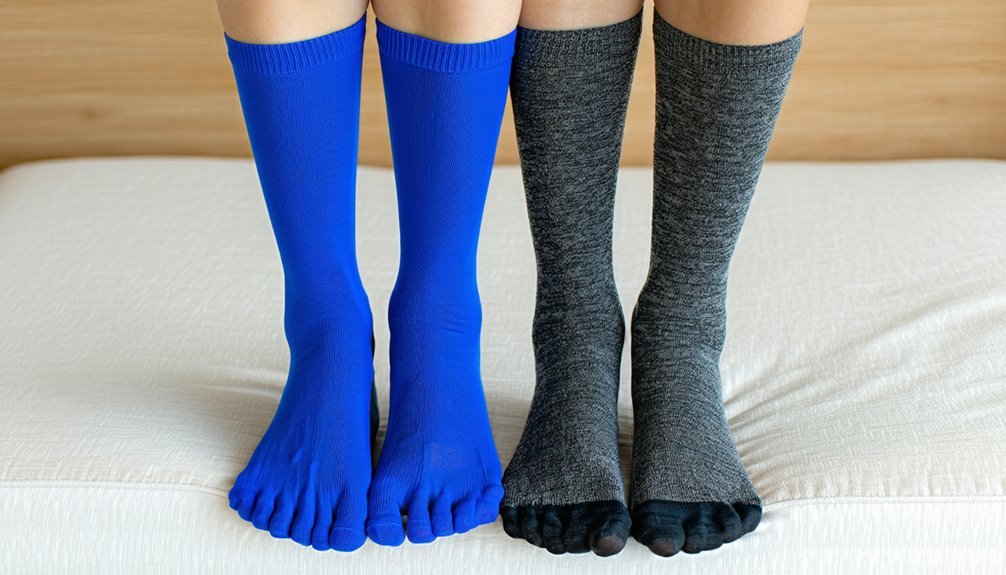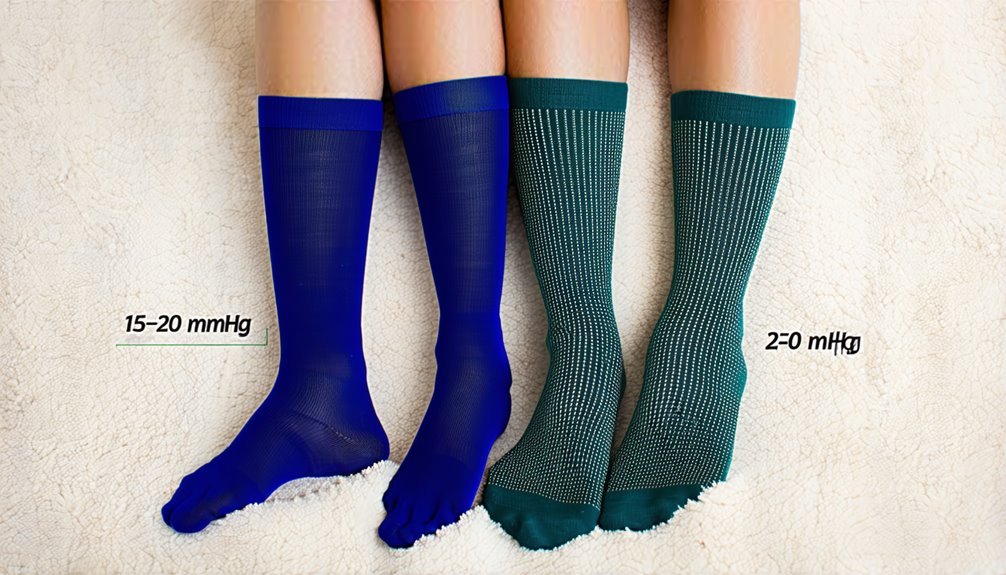Compression Socks 15 20 Vs 20 30
Compression socks with 15-20 mmHg are ideal for mild swelling or fatigue, making them perfect for travelers and everyday wear, while 20-30 mmHg socks offer significant support for serious medical conditions like chronic venous insufficiency. Consider your health status and purpose for use, as choosing the correct compression level is essential to guarantee safety and efficiency. Consultation with healthcare professionals is advisable for severe conditions. Discover more benefits, fitting tips, and maintenance guidelines.
Understanding Compression Levels

Compression levels are fundamental to understanding how compression socks can benefit your circulatory health. These levels indicate the amount of pressure exerted on your legs, measured in millimeters of mercury (mmHg). A pressure gradient is created, meaning the socks apply the highest pressure at the ankle and gradually decrease up the leg. This gradient is vital for promoting blood flow back to your heart, reducing the risk of blood pooling and clot formation. By choosing the right compression level, you guarantee the socks effectively support your vascular health without compromising safety. It's important to select a compression level that aligns with your specific needs, as improper pressure could lead to discomfort or adverse effects. Always consult a healthcare professional to determine the appropriate compression level for you.
Benefits of 15-20 Mmhg Compression Socks
When considering the benefits of 15-20 mmHg compression socks, it is essential to recognize their role in enhancing venous return and reducing leg fatigue. This level of compression is perfect for those seeking to alleviate mild swelling and discomfort safely. It's supported by evidence showing improved circulation without excessive pressure, which is important for everyday wear.
Fashion trends have popularized these socks, but a common misconception is that they're only for athletes or the elderly. In truth, they're beneficial for anyone standing or sitting for long periods. By applying gentle pressure, they help prevent varicose veins and deep vein thrombosis (DVT), ensuring leg safety. Always consider your specific health needs when selecting the right compression level to maintain peak leg health.
Benefits of 20-30 Mmhg Compression Socks
When considering 20-30 mmHg compression socks, you'll find they offer significant benefits for improved blood circulation, which is essential for preventing conditions like deep vein thrombosis. These socks also provide enhanced support stability, helping maintain proper leg alignment during prolonged periods of standing or physical activity. Additionally, they're effective in reducing swelling, making them an excellent choice for individuals with chronic venous insufficiency or those recovering from surgery.
Improved Blood Circulation
Although many factors contribute to ideal blood flow, 20-30 mmHg compression socks stand out for their efficacy in improving circulation, particularly in individuals with specific medical conditions. This level of compression applies graduated pressure on your legs, enhancing venous return and reducing the risk of venous disorders. Evidence supports these socks as a non-invasive way to promote circulation improvement, especially if you're at risk for conditions like deep vein thrombosis or chronic venous insufficiency. Here's why they work:
- Graduated Pressure: Helps veins push blood back to the heart efficiently.
- Reduced Swelling: Minimizes fluid buildup in the lower extremities.
- Enhanced Oxygen Delivery: Guarantees tissues receive adequate oxygen.
- Decreased Blood Pooling: Prevents blood from stagnating in the legs.
- Improved Venous Health: Maintains overall vein function.
Enhanced Support Stability
While many factors contribute to overall leg health, 20-30 mmHg compression socks provide enhanced support stability that is essential for both daily activities and specific medical needs. These socks offer firm, graduated pressure, which helps stabilize the muscles and joints, reducing the risk of injury during movement. Enhanced stability can improve posture by promoting proper alignment, which is critical for preventing musculoskeletal strain. Clinically, this level of compression is recommended for individuals with chronic venous disorders or those recovering from surgery. Evidence suggests that such support aids in reducing muscle fatigue, thereby allowing you to maintain an active lifestyle safely. By ensuring correct posture and support, these socks also minimize discomfort, enhancing your overall sense of well-being and safety.
Swelling Reduction Benefits
For individuals battling edema or chronic venous insufficiency, 20-30 mmHg compression socks are a valuable tool for reducing swelling. These socks offer a moderate level of pressure, effectively addressing common swelling causes by improving venous return and lymphatic drainage. This pressure aids in preventing fluid accumulation, a primary factor in swelling. Research supports their use as a reliable swelling remedy, particularly for those at risk of deep vein thrombosis or prolonged immobility. By wearing these socks, you can achieve significant reductions in limb swelling, enhancing comfort and mobility.
- Improves venous blood flow
- Reduces risk of clot formation
- Enhances lymphatic function
- Prevents fluid buildup
- Supports overall limb health
Incorporating 20-30 mmHg socks into your routine can be a proactive step toward maintaining vascular safety and health.
Comparing Pressure Levels
When comparing compression levels of 15-20 mmHg and 20-30 mmHg, it's essential to understand their distinct benefits. The lower range often suffices for mild swelling and preventive measures, while the higher range is typically recommended for more pronounced symptoms like moderate to severe varicose veins. To choose the right compression, consider both your specific medical needs and any professional recommendations to guarantee best therapeutic outcomes.
Benefits of Different Pressures
Understanding the benefits of different compression levels in socks is vital for optimizing your leg health and comfort. Compression sock materials and sock design variations play a significant role in delivering the right pressure to support vascular health. The 15-20 mmHg range is ideal for daily wear, offering mild compression to improve circulation and reduce mild swelling. In contrast, the 20-30 mmHg level provides firmer support, beneficial for managing varicose veins or post-surgical recovery.
- 15-20 mmHg: Mild pressure, ideal for everyday use.
- 20-30 mmHg: Moderate pressure, suitable for medical conditions.
- Material choice: Affects comfort and effectiveness.
- Design variations: Influence fit and pressure distribution.
- Safety: Guarantees the correct pressure is applied for your needs.
Choosing the right pressure level maximizes safety and therapeutic benefits.
Choosing the Right Compression
How do you determine the ideal compression level for your needs? Start by considering your health status and the purpose of the compression socks. For mild swelling or fatigue, 15-20 mmHg might suffice, while 20-30 mmHg suits more pronounced issues like varicose veins. Consult a healthcare provider to guarantee safety. Compression sock styles vary, allowing for both knee-high and thigh-high options, which can influence effectiveness based on your condition. Material choices also matter; breathable fabrics enhance comfort and compliance, especially for prolonged wear. Evidence supports matching the compression level to your specific symptoms and activity level, prioritizing both effectiveness and comfort. This tailored approach helps prevent complications, assuring your well-being remains uncompromised.
Who Should Opt for 15-20 Mmhg
Many individuals could greatly benefit from 15-20 mmHg compression socks, particularly those looking for mild support and improved circulation in daily activities. These socks are ideal if you're seeking to enhance athletic performance or promote daily wellness. Clinical evidence suggests that this level of compression can help reduce fatigue and prevent minor swelling. It's recommended for you if you're involved in light physical activities or spend long periods on your feet.
Consider using 15-20 mmHg compression socks if you:
- Engage in routine exercise or sports.
- Experience mild leg discomfort during the day.
- Sit or stand for extended durations.
- Travel frequently, especially on long flights.
- Wish to maintain leg health without specific medical conditions.
These socks prioritize safety and comfort, ensuring effective support.
Who Should Opt for 20-30 Mmhg
Are you considering 20-30 mmHg compression socks for more significant support? This level of compression is ideal for individuals managing specific health conditions such as chronic venous insufficiency, deep vein thrombosis, or varicose veins. It provides substantial pressure to improve blood flow and reduce the risk of blood clots. If your lifestyle factors include prolonged periods of standing or sitting, such as in professions like nursing or long-haul travel, these socks can offer enhanced relief and protection. Evidence suggests they help mitigate swelling and discomfort linked to such activities. However, it's paramount to consult a healthcare professional to ascertain this compression level is appropriate for your needs, as incorrect usage could lead to adverse effects on your circulatory health.
Ideal Scenarios for 15-20 Mmhg
While 20-30 mmHg compression socks cater to more intensive medical needs, 15-20 mmHg socks serve as a versatile option for individuals seeking moderate support. These are ideal for daily activities and adapting to various lifestyle choices. Evidence shows they effectively enhance circulation and reduce the risk of minor swelling, making them safer for regular use. Consider wearing 15-20 mmHg compression socks in the following scenarios:
- Prolonged Standing: Ideal for professions involving extended periods on your feet.
- Travel: Helps prevent discomfort during long flights or car rides.
- Mild Swelling: Useful if you experience slight edema.
- Athletic Recovery: Supports muscle recovery post-exercise.
- Pregnancy: Offers relief from mild leg swelling and fatigue.
These moderate-pressure socks balance comfort and support, enhancing your daily routine.
Ideal Scenarios for 20-30 Mmhg

When addressing more substantial medical needs, 20-30 mmHg compression socks become an essential tool in managing various conditions. These socks provide effective relief for chronic venous insufficiency, deep vein thrombosis, and severe varicose veins, guaranteeing ideal blood flow and reducing the risk of clot formation. They're not just for medical conditions; athletes can also benefit from this level of compression. Improved circulation aids in faster muscle recovery and reduces soreness, enhancing your athletic performance safely.
Evidence suggests that higher compression levels can greatly decrease leg fatigue during prolonged activities. If you've been diagnosed with more severe venous disorders, or you're an athlete seeking enhanced performance and recovery, these socks offer the necessary support. Always consult a healthcare provider to verify they're right for you.
Potential Drawbacks of 15-20 Mmhg
When considering compression socks with a pressure range of 15-20 mmHg, you might find their medical benefits somewhat limited, especially if you're dealing with more severe vascular conditions. Evidence suggests that this level of compression might be inadequate for effectively managing issues such as deep vein thrombosis or significant edema. It's essential to evaluate the severity of your condition to determine if higher compression levels are necessary to achieve the desired therapeutic outcomes.
Limited Medical Benefits
Although 15-20 mmHg compression socks are often recommended for mild symptoms, they may offer limited medical benefits for more serious conditions. From a clinical perspective, these socks have certain medical limitations and effectiveness concerns you should consider. They're typically designed to alleviate minor discomfort, swelling, and fatigue. However, if your symptoms are more pronounced, their lower compression level might not provide the therapeutic pressure required for enhanced medical outcomes. Here's why their benefits could be limited:
- Mild pressure may not address pronounced venous issues.
- Reduced effectiveness for improving significant blood flow challenges.
- Inadequate relief for moderate to severe edema.
- Limited support for preventing deep vein thrombosis in high-risk individuals.
- Potential ineffectiveness for those with specific medical conditions requiring higher compression.
Always consult a healthcare provider for tailored advice.
Inadequate for Severe Conditions
For individuals dealing with more severe conditions, 15-20 mmHg compression socks might not suffice. Clinical evidence suggests that this level of compression often provides inadequate support for managing severe venous insufficiency or advanced varicose veins. In such cases, insufficient compression can lead to suboptimal therapeutic outcomes, leaving you vulnerable to complications like deep vein thrombosis (DVT) or chronic swelling. Studies consistently show that higher compression levels, such as 20-30 mmHg, are more effective in promoting venous return and reducing edema in severe conditions. When safety is your priority, selecting a compression level that aligns with your medical needs is essential. Consulting with healthcare professionals guarantees you're equipped with socks that deliver the right pressure to mitigate risks and enhance vascular health.
Potential Drawbacks of 20-30 Mmhg

Despite the benefits of 20-30 mmHg compression socks in promoting circulation and reducing swelling, potential drawbacks shouldn't be overlooked. Higher pressure levels can lead to pressure discomfort, especially if worn for extended periods. It's essential to evaluate how long you're wearing them, as prolonged use might exacerbate discomfort and impede safety. Some individuals may experience skin irritation due to the tight fit, and improper sizing can result in restricted blood flow—a counterproductive outcome.
- Pressure discomfort: May increase with extended wearing duration.
- Skin irritation: Possible due to tightness.
- Restricted blood flow: Risk with improper sizing.
- Difficult application: Higher pressure socks can be challenging to put on.
- Not suitable for all: Certain medical conditions may contraindicate use.
Consulting a healthcare professional guarantees these socks are appropriate for your needs.
Compression Socks for Athletes
When you're an athlete, compression socks can be a strategic tool to enhance performance, aid recovery, and support muscle efficiency. Research indicates that compression levels between 15-20 mmHg are beneficial for promoting venous return, thereby reducing muscle fatigue during prolonged activities. Additionally, choosing the appropriate compression can play a significant role in injury prevention by stabilizing muscles and minimizing the risk of strains.
Benefits for Performance
Although often overlooked, compression socks can greatly enhance athletic performance by improving circulation and reducing muscle fatigue. These socks apply graduated pressure, aiding in performance enhancement by facilitating oxygen delivery to muscles. This leads to increased endurance and decreased perceived exertion. Studies suggest that wearing compression socks contributes to improved athletic recovery, allowing you to safely push your limits.
- Enhanced Circulation: Promotes efficient blood flow, reducing risk of injury.
- Reduced Fatigue: Less muscle soreness and quicker recovery times.
- Improved Endurance: Sustained energy levels during prolonged activities.
- Decreased Swelling: Minimizes edema in lower extremities.
- Comfort and Support: Alleviates strain on muscles and joints.
Recovery and Muscle Support
While often seen primarily for performance, compression socks play an essential role in athletic recovery and muscle support. You might wonder how they enhance muscle recovery. Compression socks, rated between 15-20 mmHg and 20-30 mmHg, facilitate improved blood flow, which is vital for flushing out metabolic waste post-exercise. This enhanced circulation assists in reducing muscle soreness and accelerating recovery. The support mechanisms of these socks stabilize muscle groups, minimizing vibrations during activity, which can lead to microtrauma. Clinical studies indicate that athletes wearing compression socks experience less muscle fatigue, suggesting a tangible impact on recovery times. Choosing the right compression level guarantees ideal support without compromising safety, allowing you to focus on your athletic performance with confidence.
Injury Prevention Techniques
As athletes seek to enhance performance and longevity, understanding injury prevention techniques becomes essential. Compression socks offer a strategic advantage in reducing injury risk and enhancing rehabilitation strategies. They're designed to improve circulation, stabilize muscles, and reduce swelling, thereby fostering a safer athletic experience. Here's how they can aid in injury prevention:
- Improved blood flow: Enhances oxygen delivery to muscles, reducing fatigue.
- Muscle stabilization: Minimizes vibrations, decreasing the likelihood of strains.
- Swelling reduction: Alleviates pressure, promoting faster recovery post-exercise.
- Temperature regulation: Maintains ideal muscle warmth, preventing sudden cooling.
- Support for rehabilitation: Aids in the recovery process, facilitating efficient healing.
Compression Socks for Travelers
For travelers looking to enhance circulation and reduce the risk of deep vein thrombosis during long journeys, compression socks have become an essential accessory. Evidence indicates that utilizing compression technology can considerably improve travel comfort by maintaining ideal blood flow. When selecting sock styles, consider those offering graduated compression between 15-20 mmHg or 20-30 mmHg, as these levels are clinically proven to support vascular health. The choice between these two depends on individual needs and physician recommendations. Lighter compression (15-20 mmHg) typically suffices for general travel, while higher compression (20-30 mmHg) might be advisable for those with a history of circulatory issues. Ultimately, wearing appropriately styled compression socks can effectively mitigate travel-related circulatory concerns, ensuring safer, more comfortable journeys.
Managing Medical Conditions
When managing medical conditions, especially those related to circulatory health, compression socks can be a valuable tool in your healthcare regimen. Compression therapy helps improve blood flow, reduce swelling, and prevent complications associated with chronic venous insufficiency and deep vein thrombosis. Medical recommendations often suggest using 15-20 mmHg or 20-30 mmHg compression levels based on your specific condition and health needs. For ideal safety and effectiveness, consult with a healthcare professional to determine the appropriate level of compression for you.
- Enhances venous return: Promotes efficient blood circulation.
- Reduces edema: Minimizes leg swelling.
- Prevents varicose veins: Supports vein health.
- Manages chronic conditions: Addresses long-term circulatory issues.
- Improves post-surgical recovery: Assists in healing processes.
Your careful adherence to compression therapy can considerably contribute to managing these medical conditions safely.
Choosing the Right Fit and Size
Selecting the appropriate fit and size of compression socks is pivotal for maximizing their therapeutic benefits. Ill-fitting socks can compromise circulation, negating the intended pressure levels. To guarantee the right fit, utilize size charts, which typically consider calf circumference, ankle girth, and shoe size. Fit types, such as standard or wide, also accommodate diverse leg shapes, providing ideal compression. It's crucial to measure accurately, preferably in the morning when swelling is minimal. Consider the following table for a quick reference:
| Measurement Area | Consideration | Importance |
|---|---|---|
| Calf Circumference | Check size charts | Guarantees proper fit |
| Ankle Girth | Compare to charts | Affects compression |
| Shoe Size | Align with fit types | Comfort and efficacy |
Care and Maintenance of Compression Socks
Proper care and maintenance of compression socks are essential to guarantee their longevity and effectiveness. You should adhere to evidence-based cleaning techniques and drying methods to preserve the material's elasticity and guarantee peak compression. Research indicates that improper care can lead to degradation of the fabric, compromising performance and safety.
While caring for your compression socks, consider the following guidelines:
- Hand wash with mild detergent to avoid harsh chemicals.
- Use cold water to prevent shrinkage and maintain elasticity.
- Gently squeeze out excess water without wringing, which can damage fibers.
- Air dry on a flat surface, away from direct sunlight, to maintain fabric integrity.
- Avoid using a dryer, as heat can weaken the compression material.
Frequently Asked Questions
Can Compression Socks Be Worn During Sleep?
Oh, you think wearing compression socks during sleep might enhance your comfort? Well, it could, but the truth is, most evidence suggests it's not necessary unless prescribed. Sock materials play a role, ensuring safety and proper circulation.
How Do Compression Socks Impact Blood Circulation?
Compression socks enhance blood flow by applying gentle pressure to your legs. This pressure helps veins return blood to the heart, reducing swelling and improving circulation benefits. They're evidence-based tools for promoting vascular health and ensuring safety.
Are There Any Fashion-Forward Compression Sock Options?
You're curious about fashion-forward compression socks, right? Recent studies highlight emerging fashion trends in sock styles, ensuring both safety and style. Evidence suggests you can find chic designs that don't compromise on medical efficacy or comfort.
Do Compression Socks Help With Foot Odor?
Imagine your feet dancing in a garden of fresh air. Compression socks can improve foot hygiene by enhancing circulation, which may help in odor prevention. They offer an evidence-based approach to maintaining foot safety and comfort.
Can Children Wear Compression Socks?
Yes, children can wear compression socks. The compression sock benefits include improved circulation and reduced swelling, contributing positively to children's health. However, it's essential to verify proper sizing and consult a pediatrician for safety and efficacy.






